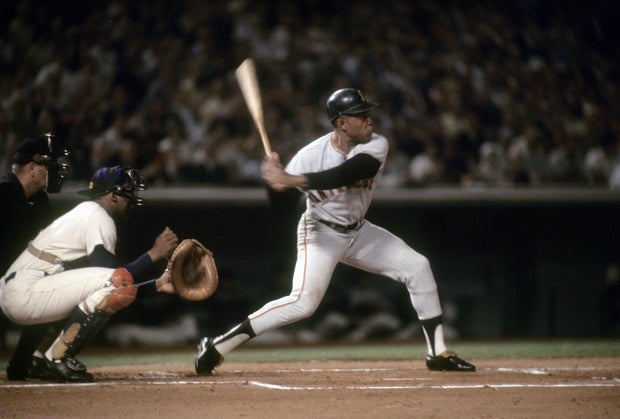Willie Mays, one of the greatest baseball players of all time, dies at age 93
Willie Mays, the iconic baseball legend whose remarkable career spanned 22 seasons, has died, the San Francisco Giants announced Tuesday. He was 93.
Mays "passed away peacefully this afternoon," the Giants said in a statement.
"All of Major League Baseball is in mourning today as we are gathered at the very ballpark where a career and a legacy like no other began," Major League Baseball Commissioner Rob Manfred said in a statement Tuesday evening. "Willie Mays took his all-around brilliance from the Birmingham Black Barons of the Negro American League to the historic Giants franchise. From coast to coast in New York and San Francisco, Willie inspired generations of players and fans as the game grew and truly earned its place as our National Pastime."
Mays had issued a statement Monday saying he would be unable to attend Thursday's Giants special tribute game against the St. Louis Cardinals, being played at Rickwood Stadium in Birmingham, Alabama, in commemoration of Mays and the Birmingham Black Barons of the Negro Leagues, with whom Mays began his professional career in 1948.
The MLB said Thursday's game will now include a "pregame ceremony honoring the life of Willie Mays."
Nicknamed the "Say Hey Kid," Mays spent the majority of his career playing center field for the Giants, first in New York and then after the team moved to San Francisco. During Game 1 of the 1954 World Series, the only championship he would win, Mays made "The Catch" — an over-the-shoulder snag of a fly ball that is still considered the greatest catch in the history of the game.
From then on, Mays was a cultural icon.
As a child, Mays learned to play baseball from his father, Cat Mays, in Westfield, Alabama. A single dad and a steelworker, Cat played on the local steel mill's baseball team and made time to teach his son how to play the game he himself had aspired to play professionally.
At 16, Mays joined the Birmingham Black Barons. After graduating from high school in 1951, he was signed by the New York Giants.
"I arrived in New York City on a Friday at 4 o'clock," Mays recalled during his Hall of Fame induction ceremony in 1979. "Scared to death with three bats in my little briefcase, my glove, I didn't have a uniform, I didn't have a hat."
It didn't take long to find his footing. Mays was named National League Rookie of the Year after his first season.
His career was interrupted in 1952 when he was drafted by the Army during the Korean War. He was assigned to Fort Eustice in Virginia, and spent most of his time playing on military baseball teams, according to the Society for American Baseball Research.
He was discharged in March of 1954, and rejoined the Giants for what would become a championship season, in which he also won his first of two MVP awards.
He moved with the team to San Francisco in 1958, led them to a World Series appearance in 1962 — losing to the New York Yankees in seven games — and became the team's captain in 1964. He won his second MVP award in 1965.
Mays was traded to the New York Mets for the 1972-73 season, which would prove to be his last.
He finished his playing career with 660 home runs, the sixth most of all time.
He was a 24-time All-Star, tied for second most of all time, and won 12 Golden Glove awards.
Mays was a first-ballot Hall of Famer, receiving 97% of the vote when he became eligible in 1979.
Despite the trade from the Giants, for the rest of his life there was always a special place for him in the San Francisco clubhouse, where a visit from Mays often inspired younger players.
A landmark statue was erected in 2000 in his honor outside of what is now called Oracle Park. The statue is surrounded by 24 palm trees, in homage to his number 24, which was also retired by the organization. The statue is a small reminder of a man who was long regarded as baseball's greatest living legend, even if that wasn't necessarily a label he cared for.
"I never like that," he said in 2011. "If you are the greatest ballplayer, you say, 'you're the greatest ball player.' Rather not the 'living ball player'. What good is that? When I first heard it, I said 'Wait a minute. You men I got to be passed away before you guys give me credit for doing something?'"
But throughout the years, Mays' combination of speed, power and defense led many to consider him the greatest of all time, living or dead.





